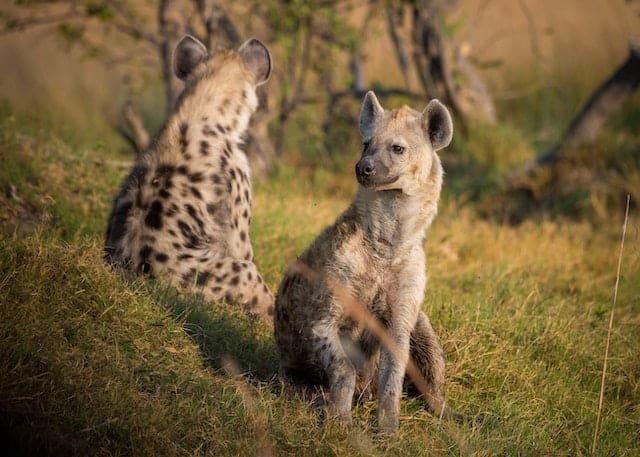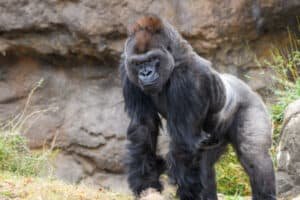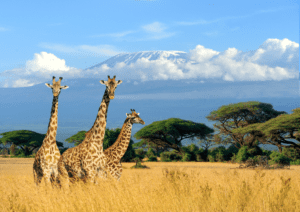The hyena belongs to family “Hyaenidae“, and they are members of the mammalian family Felidae, which is commonly known as cat family. Hyenas play an important role in the ecosystem as they are scavengers and help to keep the environment clean by eating dead animals. They are also predators and help to control populations of prey animals.
Where Do Hyenas Live? Hyenas are found in Africa, the Middle East, and Central Asia. In Africa, they inhabit woodlands, grasslands, savannas, and mountain regions. The striped hyena is the most widespread of all hyena species, while the aardwolf is the rarest and is only found in southern Africa.
Table of Contents
Where Do Hyenas Live?

1. Brown hyena (Hyaena brunnea)
Brown hyenas are found in southern Africa and Namibia. They prefer arid and semi-arid habitats such as desert, savanna, and mountain regions. These hyenas are mostly nocturnal and solitary animals. Brown hyenas are the smallest of the hyena species and have a shoulder height of 70 cm (28 in). They are brown in color with a mane of long, shaggy hair running down their back. Brown hyenas have a good sense of smell and hearing, but their eyesight is not as sharp as other species of hyenas.
Brown hyenas are good hunters and scavengers. They will eat anything from insects to larger animals such as antelope. Brown hyenas will often follow lions and other predators in order to steal their kills. These hyenas are also known to kill young animals and sometimes even people.
The brown hyena is classified as Least Concern by the IUCN Red List. This hyena species is not threatened and has a large range. Brown hyenas are protected by law in some countries, such as Namibia.
2. Striped hyena (Hyaena hyaena)
They are found in Africa, the Middle East, and Central and South Asia. They prefer dry open habitats such as deserts, steppes, and savannas. Striped hyenas are mostly nocturnal and solitary hunters. They will scavenge if the opportunity arises, but their primary diet is medium to large sized hoofed mammals that they hunt. Striped hyenas usually live in small family groups consisting of a mated pair and their offspring.
Males and females are equal in size, weighing between 40 and 60 kg (88 and 132 lb). They are the largest member of the Hyaenidae family. Striped hyenas are recognizable by their striped fur, which is grey with black stripes running along the length of the body. They have large heads and necks, small rounded ears, and long legs. Their tails are short, measuring between 20 and 30 cm (8 and 12 in).
3. Spotted hyena (Crocuta crocuta)
The spotted hyena is a highly adaptable species and can live in a variety of habitat types, including forests, woodlands, savannahs, and grasslands.
The distribution of the spotted hyena is determined by the distribution of its prey. The species prefers areas with abundant prey populations. Spotted hyenas will avoid areas where their main prey species are absent or rare. The spotted hyena is found in 39 countries in Africa. It has the largest range of any carnivore on the continent.
The majority of the spotted hyena population occurs in southern and eastern Africa. The spotted hyena is also found in north and west Africa, but these populations are much smaller.
4. Aardwolf (Proteles cristata)
Their distribution is very limited to sub-Saharan Africa. Aardwolves are found in a variety of habitats, including steppes, woodlands, savannas, and rocky areas. They seem to prefer areas with dense vegetation and plenty of insect prey.
Aardwolf populations have declined in some areas due to habitat loss and fragmentation. However, they are still common in much of their range and are not considered to be threatened.
Aardwolves are nocturnal animals that primarily eat insects. They use their long, sticky tongues to capture their prey. Aardwolf are sometimes called “anteaters” because of their similarities to other tongue-wielding animals in that family, but they are actually more closely related to hyenas.
Aardwolf are shy and solitary animals. They live in dens that they dig themselves or use ones that have been abandoned by other animals. Aardwolf mark their territories with urine and secretions from anal glands.
Protected areas for Hyenas

Namib-Naukluft Conservation Area (CA)
The Namib-Naukluft Conservation Area is a protected area in Namibia that covers an area of 49,768 km2 (19,196 sq mi). This conservation area includes the Namib Desert and the Naukluft Mountains. The Namib-Naukluft CA is home to many different animals, including the Brown hyena. Brown hyenas are protected in this area and their population is stable.
AC Skeleton Coast National Park
The most common species of this national park is the spotted Hyena, but the brown and striped Hyenas are also found in the park. The woodlands of this national park and rangeland environment support the growing population of hyenas. These particular ecosystems of this national park have high surety of food availability because of its high rich biodiversity
AC Tsau//Khaeb (restricted area)
This place holds the largest population of spotted hyenas in the world. The area is also home to other large carnivores such as lions, leopards, and cheetahs. Hyenas are often seen scavenging on the remains of animals that have been killed by these predators. Hyenas are also known to kill their own prey, particularly young or injured animals. Hyenas are most active at night, but can often be seen during the day as well. The best time to see hyenas in AC Tsau//Khaeb is early morning or late afternoon when they are actively hunting or scavenging.
Etosha National Park (NP) (Namibia)
Etosha National Park (NP) located in Nambia is home to a few thousand spotted hyenas. The mean density of hyenas was found to be one individual per 37 km2 in the central and southern regions of the park. In Etosha, hyena territories are large and may encompass up to 1,000 km2. However, most of the time, hyenas stick to a core area that is about 100-200 km2 in size. Hyenas seem to be more tolerate of other clan members than previously thought and will often share kills and allow cubs to feed first. Although, there is some evidence of infanticide among Etosha’s hyenas.
Kgalagadi transboundary NP (South Africa, Botswana)
The Kgalagadi transboundary National Park is a national park located in southern Africa. The park is situated within the Kalahari Desert and stretches over an area of 3,900,000 hectares. It is one of the largest game parks in the world and covers an area larger than Switzerland. The park is home to a variety of wildlife including lions, leopards, cheetahs, wild dogs, hyenas, antelopes, and many more. The park is also famous for its large population of Gemsbok (Oryx gazella), which are the national animals of Botswana.
The Kgalagadi transboundary National Park is a great place to see hyenas. There are three species of hyena found in the park: the spotted hyena, the brown hyena, and the striped hyena.
Makgadikgadi NP (Botswana)
Makgadikgadi National Park located in Botwana is home to a variety of hyenas, including the spotted hyena, the brown hyena, and the striped hyena. The spotted hyena is the most common, and is found in both wooded and grassy areas of The brown hyena is less common, and is found only in wooded areas of this Makgadikgadi National Park (Botswana).
Pilanesberg NP (South Africa)
Pilanesberg national park in South Africa is a supportive habitat for large number of animals, including hyenas. The park is located in the Bojanala Region of the North West Province, and covers an area of over 5,500 square kilometers. It is one of the largest game reserves in South Africa, and is home to a wide variety of wildlife.
Serengeti NP (Tanzania)
The park is also known for its distinct features, which include its vast plains and open woodlands which are highly suitable for hyenas. The place is full of prey availability and enrich in terms of suitable ecology.
Shamwari Game Reserve (RC) (Eastern Cape, South Africa)
It is a private game reserve, meaning that it is not open to the public. The size of the reserve, which covers over 25 000 hectares. The distinct feature of the reserve is its location in the hyena heartland of the Eastern Cape. These factors make Shamwari an ideal place to conserve these fascinating animals.
Central Kalahari RC (Botswana)
The distinct feature of Central Kalahari is its large size, covering over 52 000 hectares. This makes it one of the largest game reserves in Botswana. The reserve is home to a wide variety of wildlife, including the highly endangered black rhino. Central Kalahari is also one of the few places in Africa where you can see hyenas in their natural habitat.
All of these game reserves and national parks are home place and important for the conservation of hyenas.
Read Also: Why Do Hyenas Look Like Dogs





